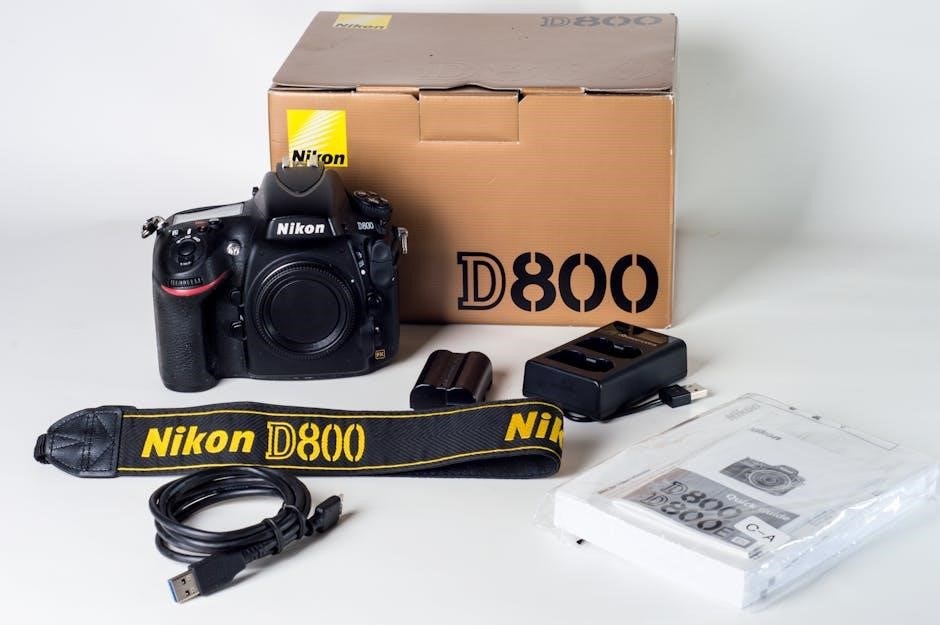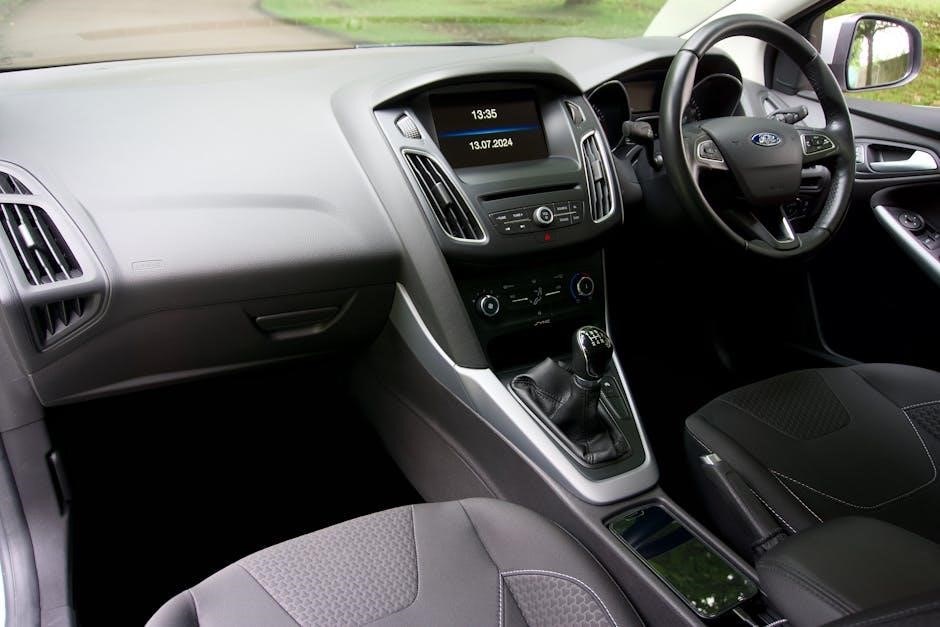Welcome to the Ford Fiesta 2012 User Manual.
Congratulations on acquiring your new vehicle! This guide provides essential information for safe and enjoyable driving.
Familiarize yourself with features, controls, and maintenance schedules to optimize performance and longevity.
Read carefully to ensure proper operation and care of your Ford Fiesta.
1.1 Congratulations on Your New Vehicle
Congratulations on acquiring your new Ford Fiesta 2012! This user manual is designed to help you understand and make the most of your vehicle’s features, safety, and performance. Reading this guide will ensure a safe and enjoyable driving experience. Familiarize yourself with the controls, maintenance schedules, and advanced technology to optimize your ownership. Proper care and attention to the details in this manual will enhance the longevity and efficiency of your Ford Fiesta. Welcome to the Ford family and enjoy the journey ahead!

Technical Specifications and Engine Details
The Ford Fiesta 2012 offers a range of engine options, including 1.4L and 1.6L, with manual and automatic transmissions, ensuring efficient performance and reliability.
2.1 Engine Overview: 1.4L and 1.6L Options
The 2012 Ford Fiesta features a 1.4L and 1.6L Duratec engine, offering 96 and 120 horsepower respectively. The 1.4L provides excellent fuel efficiency, while the 1.6L delivers enhanced performance. Both engines are paired with manual or automatic transmissions, ensuring smooth power delivery. The 1.6L Ti-VCT option includes variable camshaft timing for improved responsiveness. These engines are designed for reliability and efficiency, making them suitable for both city driving and highway cruising. Regular maintenance is essential to maintain optimal performance and longevity.
2.2 Transmission Options: Manual and Automatic
The 2012 Ford Fiesta offers a 5-speed manual transmission, designed for fuel efficiency and driver control, and a 6-speed automatic transmission for smooth, effortless shifting. The manual transmission provides precise gear changes, enhancing driving engagement, while the automatic offers seamless acceleration and convenience. Both options are engineered to optimize performance, with the automatic featuring a dual-clutch system for quick, responsive shifts. Choose the manual for sporty driving or the automatic for everyday comfort, ensuring a tailored driving experience.

Maintenance and Servicing
Regular maintenance ensures optimal performance and longevity of your Ford Fiesta. Schedule oil changes, tire checks, and inspections as outlined in the manual. Follow guidelines for fluid levels, filter replacements, and timely repairs to prevent issues. Proper servicing enhances safety, fuel efficiency, and overall driving experience.
3.1 Oil Change and Filter Replacement
Regular oil changes are crucial for your Ford Fiesta’s engine health. Use the recommended oil type and filter to ensure optimal performance. Locate the oil drain plug under the vehicle and allow the oil to drain completely. Replace the filter with a new one, tightening it by hand. Refill with the specified oil quantity to maintain proper engine lubrication. Refer to the manual for the correct procedure and schedule to avoid engine damage and maintain warranty validity. Always dispose of used oil and filters responsibly to protect the environment.
3.2 Tire Pressure Monitoring and Adjustment
The Ford Fiesta 2012 features a Tire Pressure Monitoring System (TPMS) to ensure optimal tire inflation. Check tire pressure monthly, using the inflation pressures listed on the Tire Information label on the B-pillar. Under-inflation can lead to reduced fuel efficiency and increased stopping distances. If the TPMS warning light illuminates, inspect tires for proper pressure and reset the system as described in the manual. Proper tire pressure enhances safety, handling, and tire longevity. Always refer to the manual for accurate pressure values and adjustment procedures.
Features and Controls
The Ford Fiesta 2012 offers a range of features, including manual heating, SYNC entertainment systems, and intuitive controls for steering, windows, and mirrors. These enhance comfort and convenience.
4.1 Heating and Air Conditioning Systems
The Ford Fiesta 2012 features a manual heating and air conditioning system designed to provide consistent cabin comfort. The system allows precise temperature control and air distribution settings. Drivers can easily adjust the climate using the intuitive controls located on the dashboard. The system also includes a rear window defroster for enhanced visibility during cold weather. Proper maintenance, such as regular cabin air filter replacements, ensures optimal performance. Refer to the manual for detailed instructions on operation and care of these systems to maintain a comfortable driving environment year-round.
4.2 Entertainment and Audio Systems
The Ford Fiesta 2012 offers an AM/FM stereo system with CD and MP3 compatibility, ensuring versatile entertainment options; SYNC technology enables seamless phone pairing and voice commands for hands-free control. The auxiliary input jack and USB port allow connectivity to external devices, while steering wheel controls provide convenient access to audio functions. Warning: Avoid distractions while driving. Adjust settings responsibly to maintain focus on the road. Proper care of CDs and devices ensures optimal performance. Explore these features to enhance your driving experience with quality sound and connectivity.

Safety Features and Driver Assistance
The Ford Fiesta 2012 is equipped with advanced safety features, including multiple airbags and stability control systems. These technologies enhance protection and driver control, ensuring a safer ride.
5.1 Airbags and Stability Control Systems
The Ford Fiesta 2012 features a comprehensive airbag system, including front, side, and curtain airbags, designed to protect occupants in various collision scenarios. The stability control system enhances vehicle stability by automatically adjusting engine power and braking individual wheels, helping to maintain control during sharp turns or adverse weather conditions. These systems work together to provide a high level of safety and confidence for drivers and passengers.

Troubleshooting Common Issues
This section helps identify and resolve common issues with your Ford Fiesta 2012. Refer to warning lights, error codes, and maintenance tips for quick solutions and optimal performance.
6.1 Warning Lights and Error Codes
Understanding warning lights and error codes is crucial for maintaining your Ford Fiesta 2012. The dashboard displays symbols for various system statuses, such as engine, oil, and tire pressure. If a light illuminates, refer to this manual to identify the issue. Error codes provide specific diagnostics, helping you address problems promptly. Regular checks and timely repairs ensure safety and prevent further damage. Always consult a certified technician for complex issues to maintain your vehicle’s optimal performance and reliability over time. Proper knowledge of these indicators enhances driving safety and overall vehicle longevity.
Instrument Cluster and Gauges
The instrument cluster displays vital information, including speed, engine RPM, fuel level, and temperature. The multifunction display shows time, compass, and additional vehicle data for convenience and safety.
7.1 Understanding the Multifunction Display
The multifunction display in your Ford Fiesta 2012 provides essential information at a glance. It shows the time, compass direction, and various vehicle settings. You can customize what is displayed by using the steering wheel controls. The display also alerts you to system malfunctions and provides maintenance reminders. Understanding each symbol and message ensures you stay informed about your vehicle’s status, helping you drive safely and efficiently. Regular checks of the display are recommended to monitor performance and address any issues promptly.

Fuel Efficiency and Driving Tips
Optimize fuel efficiency by maintaining proper tire pressure, driving smoothly, and avoiding excessive idling. Plan routes efficiently and use cruise control on highways to save fuel.
8.1 Maximizing Fuel Economy
To maximize fuel economy in your Ford Fiesta 2012, maintain proper tire pressure, drive smoothly, and avoid aggressive acceleration. Use cruise control on highways and plan routes to minimize idling. Regular maintenance, such as oil changes and air filter replacements, ensures optimal engine performance. Removing extra weight and using the correct fuel type also improves efficiency. By following these tips, you can achieve better mileage and reduce fuel costs while driving your Ford Fiesta.

Accessories and Customization
Explore various accessories to enhance your Ford Fiesta 2012 experience. Customize with SYNC connectivity, auxiliary input options, and additional features for improved functionality and personal style.
9.1 Pairing Your Phone with SYNC
To pair your phone with SYNC, ensure Bluetooth is enabled on your device. Go to Settings on your Ford Fiesta’s SYNC system and select “Add Device.” Choose your phone from the available devices list. Enter the PIN displayed on the SYNC screen into your phone’s prompt. Once connected, SYNC will sync contacts and allow hands-free calls and media streaming. For troubleshooting, refer to the SYNC section in your manual or visit the Ford support website for additional guidance.
9.2 Using the Auxiliary Input Jack
The auxiliary input jack allows you to connect external devices like MP3 players or smartphones to your Ford Fiesta’s audio system. Locate the AUX port, typically found in the center console. Plug in your device using a 3.5mm audio cable. Ensure your device is set to play audio through the auxiliary input. Adjust volume using your device or the vehicle’s controls. For safety, avoid adjusting settings while driving. Refer to your manual for compatibility details and troubleshooting tips to ensure optimal performance.
Electrical Systems and Components
Your Ford Fiesta’s electrical system includes the battery, alternator, and fuses, ensuring reliable power distribution. Regular maintenance is crucial for optimal functionality and safety.
10.1 Battery and Alternator Care
Proper maintenance of your Ford Fiesta’s battery and alternator ensures reliable starting and electrical system function. Check terminals for corrosion and secure connections. Avoid overcharging, as it can damage the battery. Inspect the alternator belt for wear and ensure it’s tensioned correctly; If the battery is more than three years old, consider testing its charge. Always follow the manufacturer’s guidelines for replacement. Refer to the manual for specific torque values when reconnecting terminals. Avoid incorrect polarity connections to prevent damage or safety risks.

Safety Precautions and Warnings
Always follow safety guidelines to ensure safe operation of your Ford Fiesta. Adhere to warning lights and error codes. Properly maintain brakes and airbags for optimal safety. Avoid distractions while driving and ensure all passengers wear seatbelts. Regularly inspect tires and fluids to prevent accidents. Familiarize yourself with emergency procedures outlined in this manual. Never ignore system warnings, as they indicate potential risks. Ensure all electrical systems function correctly to avoid malfunctions. Keep children secure with appropriate restraints. Be aware of vehicle load limits to maintain stability. Follow all recommended maintenance schedules to uphold safety standards. Ensure proper use of all safety features to protect occupants. Avoid overclocking or modifying systems beyond manufacturer specifications. Always refer to this manual for detailed safety instructions. Stay informed about recalls or updates that may affect your vehicle’s safety. Keep emergency contacts handy and know the location of safety equipment like the first-aid kit and fire extinguisher. Regularly check the condition of wiper blades and lights for visibility and safety. Avoid driving in extreme weather without proper precautions. Keep the vehicle well-ventilated to prevent carbon monoxide buildup. Never leave children or pets unattended in the vehicle. Ensure all doors and windows are properly closed before driving. Be cautious when handling batteries and electrical components to avoid shocks or fires. Always follow the recommended tire pressure to prevent blowouts. Keep the vehicle in a well-lit area when parked overnight for security. Familiarize yourself with the location of the spare tire and tools for emergencies. Avoid sudden maneuvers that could lose control of the vehicle. Keep the steering wheel and pedals clean and free from obstructions. Ensure the vehicle is properly grounded to avoid static electricity discharge. Regularly inspect the exhaust system for leaks to prevent carbon monoxide poisoning. Never allow unqualified persons to perform repairs or maintenance. Keep the owner’s manual in an accessible location for quick reference. Always prioritize safety over convenience when operating your Ford Fiesta. Stay alert and avoid driving when fatigued. Ensure all mirrors and cameras are clean and adjusted for clear visibility. Avoid using unauthorized accessories that may interfere with safety systems. Keep the vehicle’s software and systems updated to the latest version for optimal performance and safety. Regularly check the condition of the air filter to ensure proper engine function. Avoid driving with an overloaded trunk or uneven weight distribution. Familiarize yourself with the emergency braking system and its operation. Keep the vehicle’s keys out of reach of children to prevent accidental starts. Ensure all warning lights are understood and addressed promptly. Avoid driving in areas with standing water to prevent electrical damage. Keep the vehicle’s paint and body in good condition to prevent rust and ensure longevity. Regularly inspect the condition of the wiper blades and replace them as needed. Avoid driving with worn-out tires to maintain traction and control. Ensure all passengers are aware of safety features and emergency procedures. Keep the vehicle’s interior clean to avoid distractions and maintain a safe driving environment. Familiarize yourself with the location and operation of the hazard lights. Avoid driving with loose items in the cabin that could become projectiles in an accident. Ensure all seats are securely fastened and adjusted properly. Keep the vehicle’s doors locked while driving to prevent unauthorized access. Regularly check the condition of the seat belts and ensure they are functioning correctly. Avoid using a phone while driving unless it’s hands-free. Familiarize yourself with the vehicle’s stability control system and how it operates. Ensure all windows are free from obstructions for clear visibility. Avoid driving with the parking brake engaged to prevent damage and maintain control; Keep the vehicle’s floor mats securely in place to avoid interference with pedals. Ensure all lights are functioning properly for visibility and safety. Familiarize yourself with the location of the vehicle’s data connector for diagnostic purposes. Avoid driving in extreme temperatures without proper precautions. Keep the vehicle’s battery terminals clean and secure to ensure reliable starting. Ensure all fluids are at the recommended levels to prevent engine damage. Regularly inspect the condition of the belts and hoses for signs of wear. Avoid driving with an overheating engine to prevent damage. Ensure all warning chimes are functioning correctly to alert you of potential issues. Keep the vehicle’s keys in a safe place to prevent theft. Familiarize yourself with the vehicle’s anti-theft system and how it operates. Ensure all doors and windows are closed properly before leaving the vehicle unattended. Avoid driving with loose cargo that could shift and cause instability. Keep the vehicle’s roof rack properly secured to avoid damage and maintain aerodynamics. Ensure all child safety locks are engaged when children are in the vehicle. Regularly check the condition of the exhaust pipe for leaks or damage. Avoid driving with the fuel light on to prevent running out of fuel. Familiarize yourself with the location of the vehicle’s jack and tools for emergencies. Ensure all passengers are aware of the vehicle’s safety features and how to use them; Keep the vehicle’s interior lights adjusted to avoid distracting the driver. Avoid driving with the engine oil level below the minimum mark. Ensure all tires are inflated to the recommended pressure for safety and efficiency. Regularly inspect the condition of the airbag system to ensure it’s functioning correctly. Avoid driving with the vehicle’s computer system malfunctioning to prevent unpredictable behavior. Ensure all passengers are seated properly with seat belts fastened before starting the engine. Keep the vehicle’s emergency phone numbers programmed for quick access. Familiarize yourself with the vehicle’s traction control system and how it operates. Ensure all windows are clean and free from obstructions for clear visibility; Avoid driving with the vehicle’s weight unevenly distributed to maintain stability. Keep the vehicle’s spare tire and tools in good condition for emergencies. Regularly check the condition of the vehicle’s lights and signals for proper function. Ensure all passengers are aware of the vehicle’s emergency exit procedures. Avoid driving with the vehicle’s suspension system damaged to prevent loss of control. Keep the vehicle’s owner’s manual in the glove compartment for easy access. Familiarize yourself with the vehicle’s electronic stability control system and its operation. Ensure all doors and windows are properly closed before washing the vehicle. Avoid driving with the vehicle’s navigation system malfunctioning to prevent getting lost. Keep the vehicle’s keys away from electronic devices to prevent interference. Ensure all passengers are aware of the vehicle’s safety features and how to use them in an emergency. Regularly inspect the condition of the vehicle’s belts and hoses for signs of wear. Avoid driving with the vehicle’s engine overheating to prevent damage. Ensure all warning lights are addressed promptly to avoid further issues. Keep the vehicle’s tire pressure monitor system functioning correctly for safety. Familiarize yourself with the vehicle’s lane departure warning system and its operation. Ensure all passengers are aware of the vehicle’s blind spot information system. Avoid driving with the vehicle’s adaptive cruise control system malfunctioning. Keep the vehicle’s collision warning system functioning properly for safety. Ensure all passengers are aware of the vehicle’s emergency braking system. Regularly check the condition of the vehicle’s sensors for proper function. Avoid driving with the vehicle’s camera system obstructed to maintain visibility. Ensure all passengers are aware of the vehicle’s parking sensors and how they operate. Keep the vehicle’s anti-lock braking system functioning correctly for safe stopping. Familiarize yourself with the vehicle’s electronic brakeforce distribution system. Ensure all passengers are aware of the vehicle’s traction control system. Avoid driving
11.1 Brake System Maintenance
Regular brake system maintenance is crucial for ensuring safety and reliability. Inspect brake pads and rotors for wear every 10,000 miles. Replace worn pads immediately to prevent rotor damage. Check brake fluid levels monthly and top up as needed to maintain optimal braking performance. Avoid using brake fluid additives that may compromise system integrity. Test the parking brake regularly to ensure proper function. Address any unusual noises or vibrations promptly to prevent further damage. Always refer to this manual for detailed maintenance schedules and procedures. Ensure all brake-related repairs are performed by qualified professionals to maintain safety standards.
Driver Controls and Adjustments
Explore driver controls and adjustments, including steering wheel, power windows, mirrors, and seat settings, to customize your driving experience for comfort and convenience.
12.1 Steering Wheel and Power Windows
Adjust the steering wheel to your preferred position for comfort while driving. The power windows allow easy control of all windows, with switches located on the door panels.
For safety, ensure all windows are closed before using the air conditioning or heating systems for optimal performance.
Regular maintenance of the power window system is essential to prevent mechanical issues and ensure smooth operation.
Refer to the troubleshooting section if any issues arise with the window mechanisms.

Additional Resources and Support
For further assistance, visit Ford’s official website or authorized dealerships.
Download the full manual from trusted platforms like CarManualsOnline.info.
Explore troubleshooting guides and FAQs for specific concerns.
Engage with Ford’s customer support for personalized help.
14.1 Where to Find More Information
For comprehensive details, visit Ford’s official website or trusted platforms like CarManualsOnline.info.
Download the 360-page PDF manual for in-depth guidance.
Explore Ford forums and communities for peer-reviewed advice.
Check authorized dealerships for specialized support and updates.
Ensure all downloads are from verified sources for safety.

Final Checklist for Optimal Performance
Regularly check oil levels and tire pressure.
Inspect brakes and battery condition.
Monitor warning lights and address issues promptly.
Schedule routine maintenance as outlined.
Keep the vehicle clean and protected.
Refer to the manual for specific guidelines.
Ensure all systems function correctly.
Drive safely and efficiently for lasting performance.
